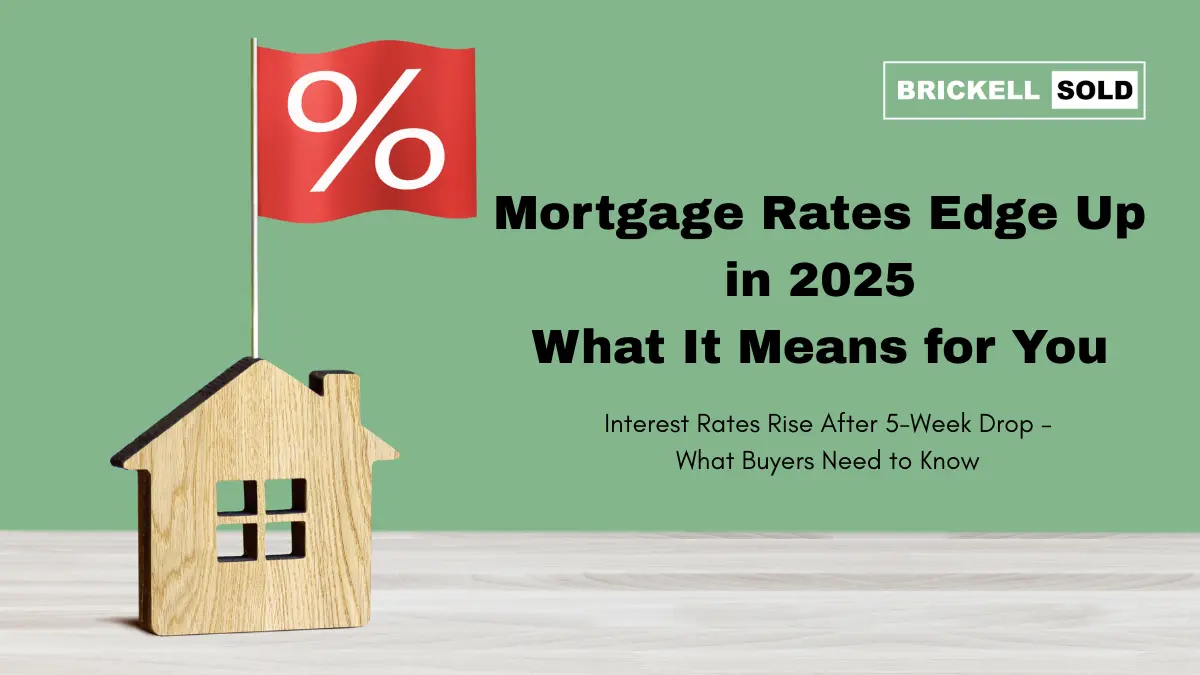Introduction
Mortgage Rates Edge Up – Mortgage rates in the United States have once again ticked upward, ending a five-week streak of declines. According to mortgage buyer Freddie Mac, the average rate on a 30-year fixed mortgage has increased to 6.72%, up from 6.67% the previous week. Likewise, 15-year mortgage rates have climbed to 5.86% from 5.80%. This movement signals renewed pressure on homebuyers and the broader real estate market, which continues to grapple with affordability concerns, low housing inventory, and buyer hesitation.
In this comprehensive analysis, we’ll explore:
-
The significance of the recent mortgage rate changes
-
Historical context of mortgage rates
-
The factors influencing current mortgage trends
-
Impacts on first-time homebuyers, refinancers, and investors
-
Regional market trends and projections
-
Tips for navigating the current mortgage landscape
-
What to expect in the coming months
Explore the hottest Miami pre construction condos for sale offering luxury, location, and long-term investment value.
The Recent Mortgage Rate Uptick: A Closer Look
Freddie Mac’s weekly survey data, released on July 11, 2025, underscores a subtle but impactful shift. The five-week decline in borrowing costs had brought slight relief to the housing market, but that trend has now reversed. The latest figures are:
-
30-Year Fixed Mortgage: 6.72% (up from 6.67%)
-
15-Year Fixed Mortgage: 5.86% (up from 5.80%)
While these changes may seem marginal at first glance, they significantly affect monthly payments and long-term affordability for borrowers.
For example, on a $400,000 home loan:
-
At 6.67%, a borrower would pay approximately $2,573/month (principal + interest).
-
At 6.72%, that rises to approximately $2,593/month.
-
Over the life of the loan, this small change could result in over $7,000 in additional interest.
Stay informed with the latest trends and opportunities in the Miami real estate investment market from our expert-led blog.
Historical Perspective: Rates Then and Now
To understand where we are now, let’s examine where we’ve been. Mortgage rates hit historic lows during the COVID-19 pandemic in 2020-2021, with 30-year fixed rates falling below 3%. That era fueled a massive housing boom and refinancing wave.
However, in 2022, inflation surged due to supply chain disruptions, fiscal stimulus, and post-pandemic recovery. In response, the Federal Reserve began raising the federal funds rate aggressively. Mortgage rates soon followed suit, climbing past 6% by late 2022 and peaking above 7% in 2023.
Discover high-rise living and waterfront options in the Brickell Miami condos for sale updated with real-time listings.
While rates have since eased slightly, they remain historically high compared to the ultra-low rates of recent memory, continuing to challenge affordability and dampen housing demand.
Get expert insights on market trends, new projects, and deals in our Brickell Miami real estate blog.
What Drives Mortgage Rates?
Mortgage rates are influenced by several macroeconomic and market-specific factors:
1. Federal Reserve Policy
Though the Fed doesn’t directly set mortgage rates, its decisions on interest rates influence overall borrowing costs. A hawkish Fed stance typically leads to higher mortgage rates.
2. Inflation
High inflation erodes the purchasing power of future repayments, making lenders demand higher interest rates. Recent inflation data has moderated, but concerns remain.
3. Bond Market Movements
Mortgage rates tend to follow the yield on 10-year U.S. Treasury notes. When yields rise, mortgage rates usually increase as well.
4. Housing Demand and Credit Risk
Investor appetite for mortgage-backed securities, which are packaged and sold on secondary markets, also plays a role. Higher perceived risk can push rates higher.
5. Geopolitical Events and Global Markets
Events such as global conflicts, oil price shocks, or supply chain issues can influence the broader economy and, by extension, mortgage rates.
Browse curated listings and upcoming developments in Florida pre construction homes for sale across key cities.
Who Is Most Affected?
1. First-Time Homebuyers
First-time buyers face a double squeeze: high mortgage rates and elevated home prices. Many are priced out of their desired neighborhoods or forced to delay purchasing altogether.
Invest early in the booming market of Miami new construction homes and condos in top-performing zip codes.
Key Challenges:
-
Reduced borrowing power
-
Higher monthly payments
-
Tougher qualification requirements
2. Homeowners Looking to Refinance
Refinancing has dropped sharply since 2021. Homeowners who locked in ultra-low rates in 2020 or 2021 have little incentive to refinance at today’s higher rates unless they are consolidating debt or pulling out equity for specific needs.
Search the best deals in Miami FL real estate for sale including luxury condos, townhomes, and waterfront properties.
3. Investors
Real estate investors are recalculating their returns. Higher borrowing costs shrink profit margins, making it harder to justify new acquisitions, especially in markets with stagnant rent growth.
Find your dream coastal home with top picks from the Fort Lauderdale real estate market—perfect for living or investing.
Housing Market Still Sluggish
The latest rate increase comes amid a housing market that’s been sluggish since mid-2022. Sales of previously owned homes plummeted to their lowest levels in nearly 30 years in 2024 and remain muted in 2025.
Discover beachfront condos and gated communities in Hollywood FL homes for sale with instant MLS access.
Reasons for the Slowdown:
-
High mortgage rates: Reduces affordability and deters buyers.
-
Limited inventory: Many homeowners are “rate locked” — unwilling to sell and give up their low interest rates.
-
Price resistance: Home prices have continued to rise, albeit slowly, compounding affordability concerns.
View luxury condos, waterfront towers, and gated homes in Aventura FL real estate listings for savvy buyers.
Regional Housing Market Trends
Sunbelt Cities (e.g., Miami, Phoenix, Austin):
-
High migration and investor activity during the pandemic years pushed prices up sharply.
-
Many markets are now stabilizing or seeing slight corrections.
Rust Belt & Midwest (e.g., Cleveland, Detroit):
-
More affordable options attract remote workers and retirees.
-
Lower price points help buffer the impact of high mortgage rates.
Coastal Cities (e.g., New York, San Francisco):
-
These areas are seeing mixed trends — softening demand in some luxury segments but stable in core urban areas due to limited supply.
South Florida (including Miami, Hallandale Beach):
-
Continues to attract international buyers.
-
Projects like Seven Park Residences highlight ongoing luxury development, catering to affluent cash buyers less sensitive to interest rate changes.
Explore affordable housing and growing communities in Hialeah FL homes for sale with great ROI potential.
Strategies for Buyers in 2025
1. Shop Around
Get quotes from multiple lenders. A difference of even 0.25% can save you thousands over the life of a loan.
2. Consider Adjustable-Rate Mortgages (ARMs)
If you’re not planning to stay in the home long term, a 5/1 ARM could offer lower initial rates.
3. Boost Your Credit Score
A better credit profile helps you qualify for the lowest available rates.
4. Buy Down Your Rate
Consider paying points upfront to lower your rate — this can be beneficial if you plan to stay in the home long term.
5. Explore First-Time Homebuyer Programs
Many states offer grants, tax credits, or reduced rates for qualifying buyers.
Check out family-friendly neighborhoods and investment-ready listings in Pembroke Pines FL real estate.
Strategies for Sellers and Developers
1. Offer Rate Buydowns or Incentives
Builders and sellers can attract buyers by offering mortgage buydowns or closing cost assistance.
2. Focus on Energy-Efficiency and Smart Home Features
Buyers are more discerning. Sustainable and tech-forward homes can command a premium.
3. Target Cash Buyers or Foreign Investors
In markets like Miami or Hallandale Beach, where many buyers don’t rely on U.S. mortgages, rate hikes have less impact.
Browse affordable new developments and townhomes in the fast-growing Homestead FL real estate market.
What’s Next for Mortgage Rates?
Analysts are divided on the trajectory of mortgage rates for the rest of 2025. Some believe rates may plateau or gradually decline if inflation cools and the Fed pauses or cuts rates. Others warn of volatility due to upcoming elections, global uncertainties, and tight housing inventory.
Key Indicators to Watch:
-
CPI (Consumer Price Index) and PCE (Personal Consumption Expenditures): These inflation gauges heavily influence Fed policy.
-
Federal Reserve Meetings: Forward guidance from the Fed will shape expectations.
-
Employment and Wage Data: Strong labor markets may keep inflation sticky.
-
Housing Starts and Building Permits: More supply can relieve pricing pressures.
Final Thoughts
The modest increase in mortgage rates to 6.72% may seem small, but it signals ongoing instability in borrowing costs and a still-unsettled housing market. As inflation, global events, and Fed policy continue to play tug-of-war with mortgage rates, buyers and sellers must remain agile.
While affordability remains a hurdle, opportunity exists — especially for those who are prepared, well-informed, and financially disciplined. Whether you’re eyeing pre-construction properties like Seven Park Residences or evaluating a resale home in a stabilizing market, success in 2025 will hinge on careful planning and a willingness to adapt.

